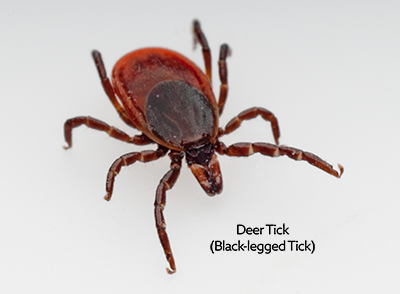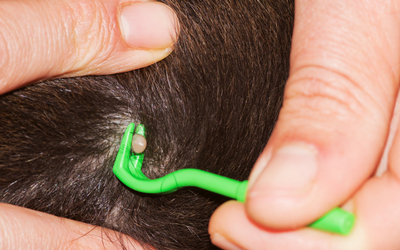Can Animals Get Lyme Disease From Ticks
What is Lyme disease?
Lyme disease is caused by a spirochete, Borrelia burgdorferi. A spirochete is a type of bacterium. 
"Lyme affliction is transmitted to dogs through the bite of a tick."
Lyme disease is transmitted to dogs through the bite of a tick. In one case in the blood stream, the Lyme disease organism is carried to many parts of the body and is probable to localize in joints or kidneys. The most mutual type of tick to carry Lyme disease is the deer tick (also known every bit the black-legged tick). Deer ticks are distributed through the Midwest and eastern U.s., every bit well every bit throughout Canada with the highest proportion in Ontario.
Tin Lyme affliction as well touch people?
Yes, but people practice not become it directly from dogs. They become it from being bitten by the aforementioned ticks that transmit it to dogs. Therefore, preventing exposure to ticks is important for you and your domestic dog.
What are the clinical signs of Lyme affliction?
Some people with Lyme disease develop a feature bull's-eye rash at the site of the bite within three to xxx days. If this occurs, the disease can exist easily diagnosed at an early phase.
However, signs of Lyme illness are more hard to detect in animals than in people. The feature rash does not develop in dogs or cats. In fact, Lyme disease is practically unheard of in cats.
"Affected dogs have been described as if they were walking on eggshells."
Many dogs afflicted with Lyme illness are taken to a veterinary because they seem to be experiencing generalized pain and have stopped eating. Affected dogs have been described as if they were walking on eggshells. Often these pets have high fevers. Dogs may also begin limping. This painful lameness often appears suddenly and may shift from one leg to another. If untreated, it may eventually disappear, only to recur weeks or months later.
Some pets are infected with the Lyme disease organism for over a year before they finally show symptoms. By this time, the illness may be widespread throughout the trunk. Non-specific signs which may indicate that Lyme disease is affecting the kidneys include vomiting, lethargy, anorexia (lack of appetite), and weight loss. The kidney form of the disease is less common, only ofttimes fatal.
How is Lyme disease diagnosed?
Dogs with lameness, swollen joints, and fever are suspected of having Lyme disease. However, other diseases may as well cause these symptoms. In that location are a few blood tests that may exist used for confirmation. The first is an antibody exam, that your veterinarian tin can perform in the clinic setting using a special test kit. This exam detects the presence of antibodies created by exposure to the organism. A test can be falsely negative if the dog is infected, but has non yet formed antibodies, or if information technology never forms plenty antibodies to cause a positive reaction. Information technology is recommended to examination no earlier than four weeks after a tick bite. Some dogs that have been infected for long periods of time may no longer have enough antibodies present to exist detected by the test. Therefore, a positive test is meaningful, but a negative is not. A follow upwards test called a QC6 test can exist done to assess the numerical antibody level as confirmation.
Other tests including PCR (polymerase chain reaction), ELISA (enzyme-linked immunosorbent analysis), joint fluid analysis, and culture can too be done with varying degrees of sensitivity, but are done less commonly. General blood and urine tests are also often done to assess kidney function and await for loss of protein in the urine. See handout "Testing for Lyme Illness in Dogs" for farther data.
How is Lyme affliction treated?
Because the Lyme spirochete is a bacterium, it tin can be treated with antibiotics. The antibiotic of pick is doxycycline, followed past amoxicillin, then azithromycin. Treatment lasts for 4 weeks. Occasionally, the initial infection will recur, or the pet will go re-infected by beingness bitten past another infected tick.
How can I prevent my dog from getting Lyme disease?
The key to prevention is keeping your dog from being exposed to ticks. Ticks are constitute in grassy, wooded, and sandy areas. They observe their fashion onto an brute by climbing to the top of a leaf, bract of grass, or short copse, especially cedar copse. Here they wait until their sensors detect an approaching animal on which to crawl or driblet. Keeping animals from thick underbrush reduces their exposure to ticks. Dogs should be kept on trails when walked near wooded or alpine grass areas. Vaccination against Lyme disease is recommended for pets that live in endemic areas or that travel to areas where Lyme affliction is prevalent.
"Vaccination confronting Lyme disease is recommended for pets that live in endemic areas or that travel to areas where Lyme disease is prevalent."
At that place are also several products available that tin help to impale these ticks and preclude affliction manual. Some products are available over the counter, while others are just available through your veterinarian. There are effective monthly preventatives that are typically applied to the pare at the back of the neck and stand for a convenient method of control for these external parasites. This includes Frontline Plus® (only bachelor in the USA) and Advantix®. In recent years, the topical Bravecto® has been developed and lasts for 3 months when applied topically. Additionally, there are chewable products such equally Nexgard® and Simparica® that are given monthly or chewable Bravecto® which is given every 3 months. Your veterinary will make specific recommendations to keep your pet parasite gratis.
How practice I remove a tick from my dog? 
Cheque your pet immediately after information technology has been in a tick-infected area. The deer tick is a modest tick and only about pinhead size in juvenile stage, only is a niggling more than obvious in the adult stage and after feeding. If you find a tick moving on your pet, the tick has non fed. Remove the tick promptly and identify information technology in rubbing booze or beat information technology between two solid surfaces. If yous notice a tick fastened to your pet, grasp the tick with fine tweezers or your finger nails near the dog's skin and firmly pull it direct out. There are also tools available called Tick Twister® or Tick Key® which tin can exist useful. Notwithstanding, accept care to utilise them cautiously as twisting or jerking the tick may cause the oral cavity parts to break off and remain in the skin. See your veterinarian if you are unsure or unable to remove the tick from your dog.
Make sure you protect your fingers from exposure by using a tissue or a disposable glove.You may demand another person to assist restrain your dog. Removing the tick apace is of import since the affliction does not announced to be transmitted until the tick has fed for approximately 12 hours. If you trounce the tick, do not go the tick's contents, including blood, on your skin.
Note: The bacterium that causes Lyme affliction can pass through a wound or cut in your skin.
Is there a vaccine that volition protect my domestic dog from Lyme disease?
A rubber and generally effective vaccine is available for protecting dogs against Lyme illness. This vaccine is initially given twice, at two- to iv-week intervals.
"Almanac revaccination is necessary to maintain amnesty."
Annual revaccination is necessary to maintain immunity. Vaccination against Lyme affliction volition be determined by your pet'southward lifestyle and individual risk cess. Be certain to discuss any questions you may have regarding the type and frequency of vaccination with your veterinary.
Source: https://vcahospitals.com/know-your-pet/lyme-disease-in-dogs
Posted by: butlerqueent.blogspot.com


0 Response to "Can Animals Get Lyme Disease From Ticks"
Post a Comment